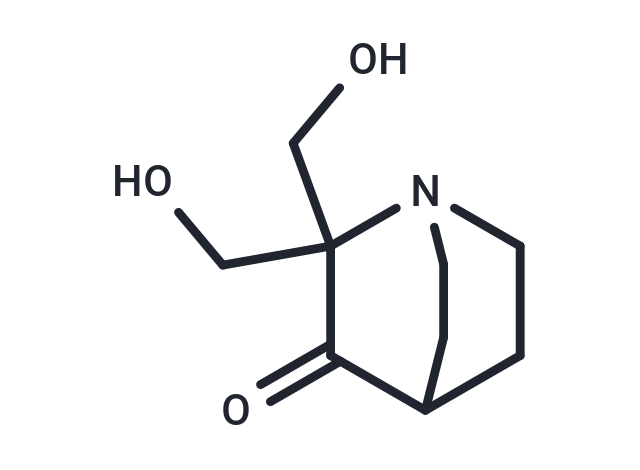Shopping Cart
Remove All Your shopping cart is currently empty
Your shopping cart is currently empty
PRIMA-1 (NSC-281668) is a mutant p53 reactivator that induces apoptosis and inhibits the growth of human tumors with mutant p53.

| Pack Size | Price | USA Warehouse | Global Warehouse | Quantity |
|---|---|---|---|---|
| 5 mg | $47 | In Stock | In Stock | |
| 10 mg | $67 | In Stock | In Stock | |
| 25 mg | $143 | In Stock | In Stock | |
| 50 mg | $217 | In Stock | In Stock | |
| 100 mg | $387 | In Stock | In Stock | |
| 200 mg | $576 | In Stock | In Stock | |
| 500 mg | $923 | - | In Stock | |
| 1 mL x 10 mM (in DMSO) | $52 | In Stock | In Stock |
| Description | PRIMA-1 (NSC-281668) is a mutant p53 reactivator that induces apoptosis and inhibits the growth of human tumors with mutant p53. |
| In vitro | PRIMA-1 is converted to compounds that form adducts with thiols in mutant p53. Modification of thiol groups in mutant p53 by PRIMA-1 conversion products is sufficient to restore its tumor suppressor activity.[2]. PRIMA-1 inhibits the growth of pancreatic cancer cell lines and induces cell cycle arrest and decreases DNA synthesis. It selectively induces apoptosis and cell death in mutant p53-expressing pancreatic cancer cells and also leads to activation of p53-dependent apoptotic pathways. PRIMA-1 enhances the cytotoxicity of chemotherapeutic agents active against mutant p53 pancreatic cancer cells[1]. PRIMA-1 has antileukemic properties in acute promyelocytic leukemia-derived NB4 cells. PRIMA-1-triggered apoptosis is in a dose-dependent and time-dependent manner as indicated by the MTT assay and annexin-V staining. Apoptosis induction by PRIMA-1 is associated with caspase-9, caspase-7 activation and PARP cleavage. PRIMA-1 does not show any significant apoptotic effect in normal human peripheral blood mononuclear cells[4]. |
| In vivo | Intravenous (i.v.) injections of PRIMA-1 in mice does not cause any obvious changes in weight or behavior compared with untreated animals. PRIMA-1 has in vivo antitumor activity in this animal tumor model. It suppresses in vivo tumor growth in a mutant p53-dependent manner[3]. |
| Cell Research | Cells are kept at a temperature of 37 °C, a minimum relative humidity of 95 %, and an atmosphere of 5 % CO2 in air. Cell viability is measured by MTT assay after treatment with PRIMA-1. Briefly, cells are seeded in each well of 96-well plates in 100 μl culture medium and incubated overnight at 37 °C in an atmosphere of 5 % CO2. The next day, the medium is removed and cells washed with PBS and treated with vehicle control(DMSO, dimethylsulfoxide) or different concentrations of PRIMA-1 for 12 to 48 h; the medium is replaced with MTT solution diluted in medium once the treatment is completed. The plates are further incubated at 37 °C under 5 % CO2 for 4 h and then left at room temperature until completely dry. DMSO was then added and the absorbance is read at 492 nm using a microplate enzyme-linked immunoassay reader (ELISA). The relative growth activity is determined as the percentage absorbance of treated cells compared to that of vehicle treated cells (control).(Only for Reference) |
| Synonyms | PRIMA 1, NSC-281668, 2,2-Bis(hydroxymethyl)-3-quinuclidinone |
| Molecular Weight | 185.22 |
| Formula | C9H15NO3 |
| Cas No. | 5608-24-2 |
| Smiles | OCC1(CO)N2CCC(CC2)C1=O |
| Relative Density. | 1.32g/cm3 |
| Storage | Powder: -20°C for 3 years | In solvent: -80°C for 1 year | Shipping with blue ice/Shipping at ambient temperature. | ||||||||||||||||||||||||||||||||||||||||
| Solubility Information | Ethanol: 35 mg/mL (188.96 mM), Sonication is recommended. H2O: 18.5 mg/mL (99.88 mM), Sonication is recommended. DMSO: 50 mg/mL (269.95 mM), Sonication is recommended. | ||||||||||||||||||||||||||||||||||||||||
| In Vivo Formulation | 10% DMSO+40% PEG300+5% Tween 80+45% Saline: 2 mg/mL (10.8 mM), Sonication is recommended. Please add the solvents sequentially, clarifying the solution as much as possible before adding the next one. Dissolve by heating and/or sonication if necessary. Working solution is recommended to be prepared and used immediately. The formulation provided above is for reference purposes only. In vivo formulations may vary and should be modified based on specific experimental conditions. | ||||||||||||||||||||||||||||||||||||||||
Solution Preparation Table | |||||||||||||||||||||||||||||||||||||||||
H2O/Ethanol/DMSO
Ethanol/DMSO
| |||||||||||||||||||||||||||||||||||||||||
| Size | Quantity | Unit Price | Amount | Operation |
|---|

Copyright © 2015-2025 TargetMol Chemicals Inc. All Rights Reserved.